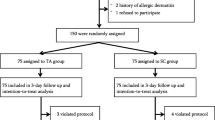Abstract
Purpose
Skin incision before percutaneous central venous catheterization may cause serious hemorrhage and/or skin cicatrization. To minimize these adverse effects, we improved the shape of a dilator and coated it with lubricant to reduce insertion load.
Methods
We selected three types of dilators from different manufacturers. Each brand was widely available on the market in Japan. We redesigned one model with modified multitapering angles. Six types of dilators in total (three manufactured dilators, one manufactured dilator with lubricant, and the newly modified dilator +/− lubricant) were examined regarding load of insertion using pork muscle covered with porcine skin. Among these dilators, two manufactured dilators and the newly modified one with lubricant were also investigated regarding insertion load with or without skin incision.
Results
The minimum load of insertion was observed in the newly modified dilator with lubricant. The modified dilator attenuated the insertion load by up to 50% of the manufactured dilator, and the lubricant also reduced load by up to 16%. The insertion load of the modified dilator coated with lubricant was comparable to that of the manufactured dilators inserted with a 2-mm skin incision.
Conclusion
The lubricant-coated dilator with multitapering angles was associated with decreased insertion load and thus facilitated its insertion without skin incision.
Similar content being viewed by others
Author information
Authors and Affiliations
About this article
Cite this article
Takahashi, T., Morita, M. & Shimada, Y. Evaluation of dilators for central venous catheterization using an experimental model. J Anesth 19, 131–135 (2005). https://doi.org/10.1007/s00540-004-0292-y
Received:
Accepted:
Issue Date:
DOI: https://doi.org/10.1007/s00540-004-0292-y




